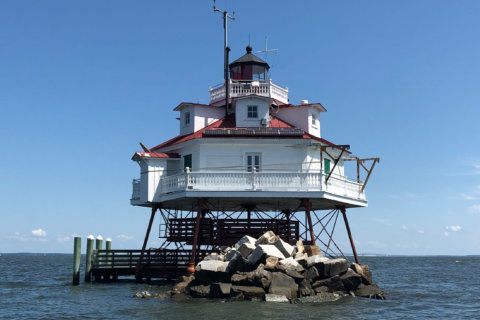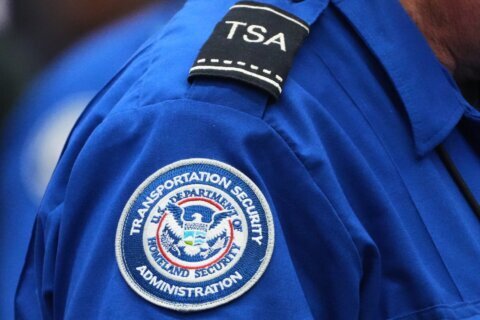This article was republished with permission from WTOP’s news partners at Maryland Matters. Sign up for Maryland Matters’ free email subscription today.
This content was republished with permission from WTOP’s news partners at Maryland Matters. Sign up for Maryland Matters’ free email subscription today.
The Maryland Department of Transportation will not seek approval of a multibillion-dollar contract to build toll lanes on Interstates 270 and 495 until late winter, after Gov. Larry Hogan (R) has left office, the agency announced on Thursday.
The decision is a significant blow to the long-planned project, one of Hogan’s top transportation priorities, as its fate will soon rest with three Democrats, Gov.-elect Wes Moore, Treasurer Dereck Davis and Comptroller-elect Brooke Lierman.
Moore and Lierman will assume positions on the contract-approving Board of Public Works (BPW) when they are sworn in, in mid-January. They will replace the term-limited Hogan and Comptroller Peter Franchot (D), whose bid for governor fell short. Franchot has voted to advance the project in the past after winning key concessions. (Davis is expected to remain on the board, though he must win re-appointment as treasurer by the legislature.)
In a news release, Transportation Secretary James Ports said the agency has decided to grant its contractor, Accelerate Maryland Partners, more time to complete planning, design, and financing. The extension was necessitated by what he called the federal government’s “10-month delay” in approving the toll lanes plan.
“Thanks to a lot of hard work, MDOT is proud to have secured the Record of Decision for this key project to replace the American Legion Bridge and provide congestion relief and additional travel options to commuters in the National Capital Region,” said Ports. “Achieving this important milestone is a critical step forward for this transformational project.”
Hogan unveiled plans to add four variably-priced toll lanes to sections of the Capital Beltway and Interstate 270 in 2017, and he hoped to get a construction project to the BPW before he left office.
Moore has said publicly he would like to see changes to the project and it is far from certain he would embrace the general concept of “express lanes,” which critics call “Lexus lanes” because of the way tolls can escalate during periods of peak demand. Moore told WAMU Radio (88.5 FM) host Kojo Nnamdi in August that he would like to see “a new type of proposal,” one that emphasizes reversible lanes, increased transit and greater collaboration with local “stakeholders.”
Lierman has also been a skeptic of the plan’s ability to ease traffic congestion in the region.
Montgomery County Executive Marc Elrich (D), a leading critic of Hogan’s plan, expressed hope over the summer that Hogan’s successor would take a fresh approach to relieving traffic congestion on the two heavily-travelled thoroughfares.
Business interests hailed Hogan’s 2017 announcement, which was delivered with much fanfare. His initial plan, patterned after Northern Virginia, which has an extensive network of toll lanes operated by the Australian transportation behemoth Transurban, included the entire Maryland portion of the Beltway, all of I-270 and the federally-owned Baltimore-Washington Parkway. As envisioned, motorists could pay to use barrier-separated toll lanes, bypassing traffic in existing lanes, which would remain free. The concessionaire would be responsible for maintenance on both the toll lanes and the free lanes.
Business leaders and the governor’s then-transportation secretary, Pete Rahn, hailed the plan as a breakthrough, saying it would reduce commuting times and boost the state’s economy. They said the governor’s use of a public-private partnership was essential, because the state lacked the borrowing capability to add new lanes.
But critics dogged the project from the start. Homeowners worried that their homes would be taken to make way for wider highways. Environmental groups warned of increased air and water pollution. And social justice advocates said lower-income workers would be leap-frogged by workers able to buy their way out of traffic.
In addition, federal and local planners raised numerous objections. Good government advocates saw an attempt to wire the lucrative contract to a group headed by Transurban, a company that hired a former Hogan administration aide as part of its pursuit of the contract. And one transit advocate accused MDOT of manipulating data in a key federally-mandated report.
When Accelerate Maryland Partners, a Transurban-backed consortium, won a preliminary design contract, one of the losing bidders sued. Capital Express Mobility Partners won a procedural ruling from a Montgomery County judge, a decision that was upheld by the Court of Appeals, setting the stage for a trial on the merits later this month.
State transportation officials, with Hogan’s blessing, made numerous significant changes to the project in a bid to satisfy critics. The state postponed indefinitely plans to add toll lanes to the portion of the Beltway that runs between the I-270 spurs and I-95, and they restructured the project to begin with the replacement of the 60-year-old American Legion Bridge.
When federal transportation officials issued a key approval in August, it appeared that Hogan might be able to squeeze the toll lanes through the procurement pipeline before leaving office in January, despite the looming lawsuit.
Commuters in the Washington, D.C., region face some of the worst traffic in the nation and the decision to delay action until March — or later — is a huge blow, particularly given Moore’s stated desire to seek a different path.
This is a breaking news story and will be updated.







